As residential development spills into forested areas around Asheville and throughout Western North Carolina, citizens’ encounters with wildlife have become increasingly routine. For the black bear — the region’s largest wild animal — human residences offer an enticing smorgasbord of trash, birdseed and other alternatives to their natural diets.
While bears generally avoid confrontations with human residents, the possibility of negative interactions increases with proximity. Disruptive (and messy) bear activity has residents in Asheville and elsewhere pushing municipalities to explore ways to mitigate negative encounters.
Municipal officials and wildlife experts on the local and state levels are exploring the feasibility of bear-resistant cans and ordinances designed to limit the feeding of wildlife, while simultaneously addressing common misconceptions about bears to ensure our furry neighbors stay wild and safe.
Da bears
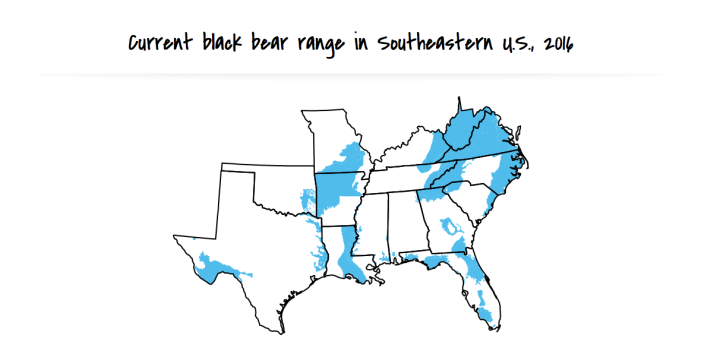
Black bears are a familiar sight around most of the Southeast, according to Colleen Olfenbuttel, black bear biologist with the North Carolina Wildlife Resources Commission. According to data from the agency, black bear populations can be found in parts of every state in the region.
“The bear population’s definitely not in a square box,” Olfenbuttel says. “Bears don’t recognize state lines.” The Southern Appalachians, with broad valleys and river corridors, offer appealing environs to bears. The Asheville area in particular, Olfenbuttel adds, is a prime bear habitat. “When you look at the city, except for the core downtown, it’s fairly heavily wooded,” she notes. “Lots of trees, gullies and travel corridors that have mast-producing oak trees, berries and hiding cover.”
According to Olfenbuttel, well over half the phone calls the Wildlife Commission receives concerning bears come from densely populated Buncombe County. “We get them often from Beaucatcher Mountain, Swannanoa and Black Mountain,” she reports. “People love towns nestled in the mountains, but so do bears.”
Asheville resident Tom Gallo, who lives in the Beaverdam area of North Asheville, has plenty of firsthand experience with his ursine neighbors. “It’s a regular occurrence: bears getting into our trash, coming up on our deck because we had grilled salmon,” he recounts. “A bear broke my pizza stone that was out by the grill.”
Bears’ attraction to populated areas is reinforced by easy pickings like trash cans and bird feeders. “They stop being afraid of people because they’re being rewarded for being near people,” Olfenbuttel says.
Nuisance nuances
With such a robust bear population living nearby — the Wildlife Resources Commission estimates 5,000 bears inhabit WNC — the chances of seeing one in a residential neighborhood are good. Despite their prevalence, though, complaints related to bears are down 15 percent from 2016, according to Sue McMullen, Asheville’s animal services supervisor.
Still, says Olfenbuttel. “We get phone calls from the public about bears in neighborhoods, bears on porches and in backyards,” she says. “I would say 95 percent of the time, at least, we identify that the bear is not a nuisance.”
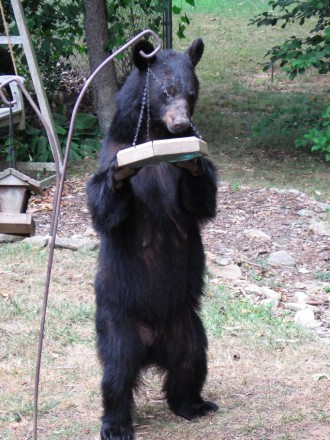
Media reports of aggressive and violent bears can sometimes give people the wrong impression, says Cynthia Strain, a Highlands resident and member of MountainTrue’s Bear Education and Resources task force. “I heard about one woman who would not walk around the neighborhood because she was frightened of being attacked by a bear,” Strain says. “That’s completely unfounded — for the most part, we don’t need to fear bears, we just need to respect their needs to be wild.”
When a problem bear does arise, Olfenbuttel says, her department’s options are limited. “In North Carolina, we don’t relocate bears, because that’s only moving the problem to someone else’s area,” she says. Bears that wildlife management officials deem to pose a threat to residents are trapped and subsequently euthanized.
Such instances, however, are rare. “We have not had to trap and euthanize a problem bear for years,” Olfenbuttel says. “When we hear about bears starting to become habituated, we really try to get people to fix the problem themselves.”
While residents can legally shoot a bear that is causing property damage or acting aggressively toward humans, such action usually results in an investigation by the Wildlife Resources Commission. “We will investigate and make sure that you truly had a safety situation,” Olfenbuttel says. “We don’t want people to just see a bear in the neighborhood, get scared, go in and come back out with their firearm and then shoot the bear.”
Killing a “nuisance” bear can also result in unintended consequences, adds Strain. Her task force is raising money to fund the care of cubs orphaned at Wildcat Cliffs Country Club last spring. “A homeowner shot a mother bear who had broken into his house and car several times and caused a lot of damage,” Strain says. “That left four little baby cubs that were about 5-7 pounds.”
Grin and bear it
Addressing issues in bear-human interactions before they reach a lethal level is a primary goal of her agency, says Olfenbuttel. To help educate citizens on bear behavior and mitigate negative interactions, the Wildlife Resources Commission, in tandem with other state wildlife authorities in the Southeast, recently launched BearWise.org to provide a comprehensive resource for black bear facts and preventative measures.
The organization urges residents to clean outdoor grills after use, remove pet food from outdoor areas, store bird feeders and secure garbage.
“Birdseed is highly caloric,” Olfenbuttel notes. “A bear doesn’t have to eat as much birdseed to get what it needs in calories, as opposed to spending all day finding berries.” While she understands the desire to help provide for bird populations, Olfenbuttel says nature provides plenty of food for birds except during the winter months.
Trash cans and can’ts
Some residents see bear-resistant receptacles as the most logical solution to the problem. But finding a durable bearcan that also works with waste collection equipment can be a challenge.
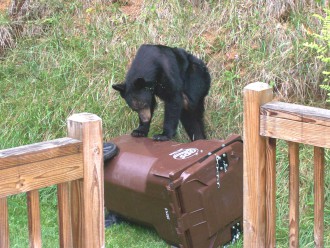
“I learned that many, many people say they have a cheaper solution but they all have bearcan conversion systems that have to be left unlocked at the street,” says Gallo, who’s been researching bear-resistant receptacles for the past year. “That means dinnertime for the bears,” he adds, since bears in his neighborhood have been known to hang around on trash day until residents put their garbage out.
Of all the companies he’s researched, Gallo says that Kodiak Products’ bearcan seems to offer the best combination of effectiveness and convenience. “[That bearcan] remains locked at the street,” he says. “It unlocks when turned upside down by the trash truck arm.”
Since he purchased a Kodiak bearcan, Gallo says, several of his neighbors, especially those who manage apartments and condos, have expressed interest in obtaining one as well. “They would buy them today,” he reports.
A single Kodiak can cost $275. Purchasing 100 cans at once drops the price to $255, but shipping can add thousands to the cost. City officials and wildlife experts also question the long-term effectiveness of bear-resistant cans, especially considering the abuse they take over time.
“Nothing is guaranteed to be ‘bear-proof,’” says Jes Foster, Asheville’s new solid waste manager. “A bear-resistant can merely makes it more difficult or time-consuming for a bear to get what it wants.” Even in cases where they work, bears will often move on to a more easily accessible can nearby, she adds.
With bear issues involving garbage generally isolated to a few areas in East and North Asheville, Foster says that the city has put the idea of implementing citywide bear-resistant cans on the backburner for now.
Gallo says he understands the city’s hesitation to invest in bearcans but believes that residents should have the option to use one, even if they have to foot the bill themselves. “I do not want the city to spend about $3 million on bearcans for those who need one, [but] let people buy one,” he says. “If the city buys in bulk they can get bearcans for about $250 plus $35 for shipping. Maybe give people a credit, $50, for turning in their regular trash can.”
Legal bearings
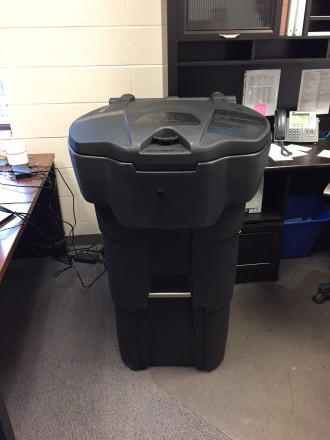
The most effective strategy for dealing with bear issues, wildlife experts and advocates agree, is getting community members on the same page. “We highly encourage people to talk to their neighbors,” says Olfenbuttel. “We get situations where a person doesn’t have anything that would attract a bear around their home, but if their neighbor’s not doing the same, the bears will still come around.”
Residents who purposefully feed bears can create a hazard not only for themselves, but also for others living nearby, she adds. While police and wildlife officials explain the potential risks, there is little legal leverage to compel compliance with the suggestions. “To be honest, there’s nothing we can do,” Olfenbuttel acknowledges. “People just don’t listen sometimes.”
While other Appalachian towns like Gatlinburg, Tenn., have enacted ordinances that require businesses to secure trash cans and prohibit feeding bears, passing similar rules in WNC has proven difficult. Several initiatives in area communities have been voted down, in part due to uncertainty about how regulations might be applied.
“People are concerned that if a bear gets in their bird feeder, they’ll get a fine,” says Olfenbuttel. “In North Carolina, we do allow hunters to use the aid of unprocessed food to harvest bears; I think there would be concerns from hunters that any feeding law would prohibit them from doing that.”
Despite this opposition, she believes that passing ordinances like the ones implemented in Gatlinburg would go a long way toward addressing bear problems close to home. “There’s definitely benefits of having an anti-feeding law,” Olfenbuttel says. “We just have to work with all the various stakeholders to address their concerns. I think it definitely could be done, because other states have been able to do it successfully.”
Gallo agrees that local officials need to be proactive in addressing the issue. “This is truly serious,” he says, noting that on nearby Bassett Road, several residents have been charged by a mother bear with three cubs. “I have asked the City Council to do something before we end up on the 7:00 p.m. news.”
Bear necessities
In the meantime, the Wildlife Resources Commission and local advocacy groups are promoting a holistic approach to living in harmony with bears in WNC.
In addition to BearWise.org, Olfenbuttel says the state is exploring the idea of “BearWise” community certification, which would recognize municipalities’ efforts to reduce bear attractants in their town. The certification could include cost-share programs for the purchase of bear-resistant trash cans. “Florida has a program where, if a neighborhood wants to become BearWise, they have to do about three different things to get certified,” she says.
Asheville, with its environmentally conscious human population and close proximity to bear populations, is a prime candidate for any pilot programs the state may conduct, she adds.

A similar local initiative, run by the Whittier-based organization BearSmart, has spent years aiming to get mountain communities certified, says Strain. “It’s basically an inventory of bears and the issue of documenting bear conflicts and what efforts have been made, and what we recommend for communities,” she says.
In Highlands, Strain says, “We just haven’t found a great interest from the Town Board in moving forward with our suggestions, so we just kind of shelved that whole process for now, which is a shame.”
Bearer of good news
For now, Strain’s group is working to raise money to send the orphaned bear cubs from Wildcat Cliffs to an animal refuge until they reach adulthood. “It costs about $20,000 to rear these cubs for the next year,” Strain says. “So far, we’ve got about $3,000, but we still have a long way to go.”
The Wildlife Resources Commission, meanwhile, is collaborating with neighboring states to track and inventory the bear population in the mountains, says Olfenbuttel. “We meet twice a year just to talk and update each other on our mast surveys and some of the other surveys we conduct on human-bear interactions.”
For residents with bear questions, or those interested in learning more about the BearWise initiative, Olfenbuttel suggests visiting BearWise.org or calling the agency’s 1-800 wildlife hotline (see sidebar, “Bear Watch”). “We’re only as successful as those people that are willing to help us,” she adds. “Anyone that’s interested in their community becoming BearWise, we want to talk to.”
How communities respond to these efforts will go a long way in determining the long-term health of bear populations. “Bears have adapted to living near humans and human disturbances,” Olfenbuttel says. “They’ve shown they can live near us, but can we adapt to bears? I’m hoping the answer is always yes.”



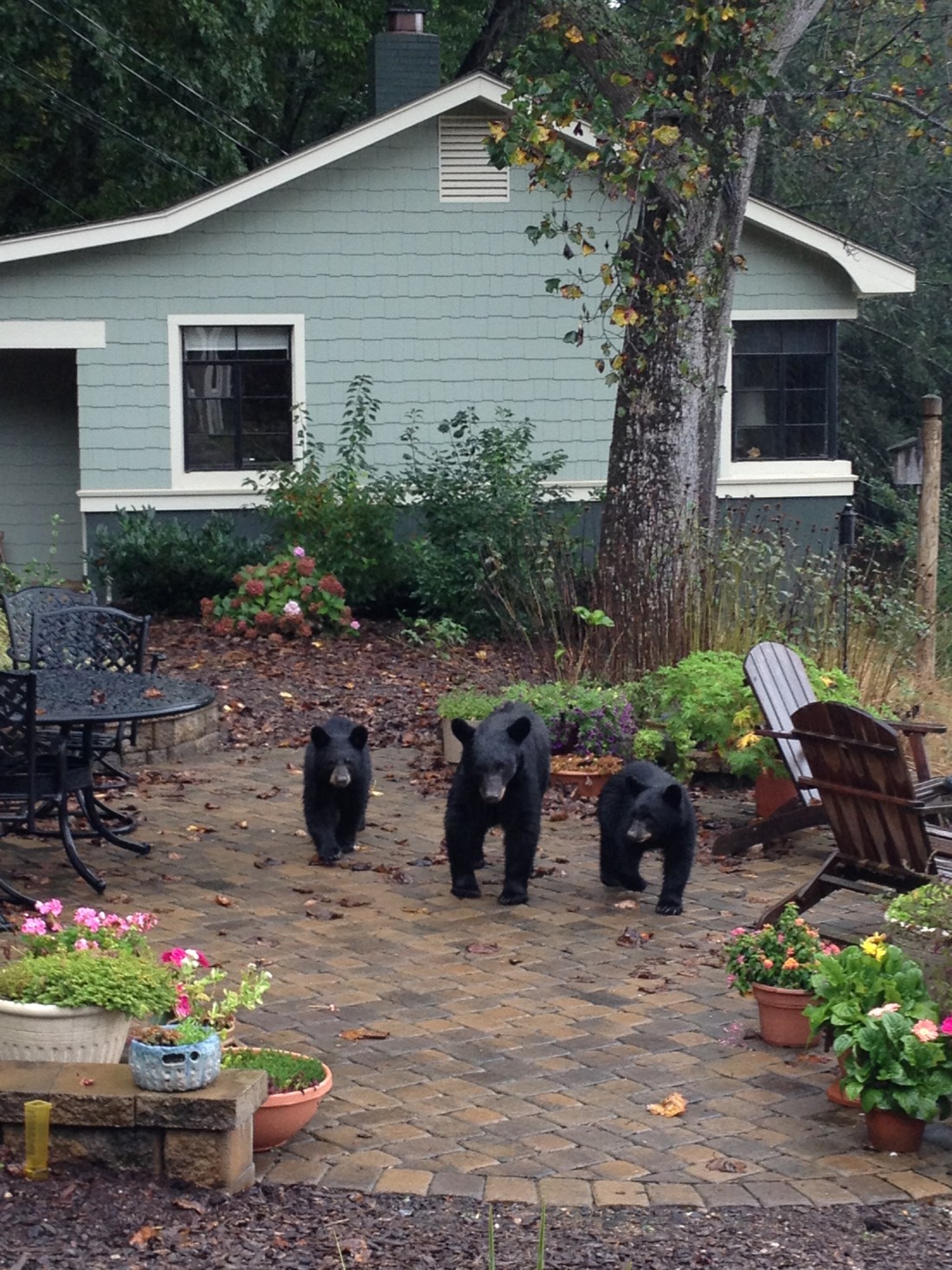
Have encountered bears several times while hiking at Craggy Gardens, as well as on the trail to the summit of Mt. Pisgah. Never had a problem with them, nor they with me. Actually thrilled me, as seeing other wildlife such as deer, foxes, and an occasional bobcat are relatively common, to see a majestic black bear out in nature is awe-inspiring….just remember to give them a wide berth as well as the right-of-way..you are the visitor here, mind your manners.
Just do not mess with the cubs. Momma bear is hiding in the bushes. And she will charge you is you try to walk by the cubs or even drive by them. It happened to me in the Stoneybrook subdivision around 2008. Be sure to keep your trash can free of nice smelling foods leftovers. You could spray stinky bug spray on the bags. My neighbor the bears are smart and drag the bags across the road and have a picnic at 5 am on trash day.